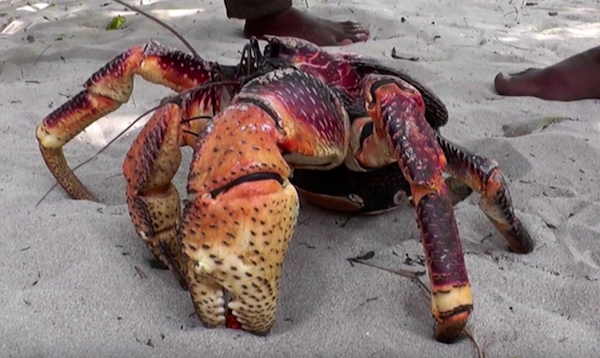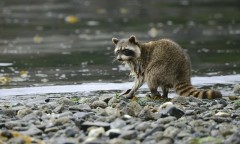By Vishal Goel, | November 26, 2016

The Coconut crab is the largest crab in the world. (YouTube)
The coconut crab, which is native to islands in the Indian and Pacific Oceans, can grow up to three feet with a weight of nearly nine pounds. Being the largest terrestrial crabs, they try to eat whatever they get their burly claws on. Most of their diet includes vegetation like the hard-shelled coconut (that's why they are called coconut crabs), they are also known to prey on other small animals like kittens.
Like Us on Facebook
Due to the massive force that coconut crabs (Birgus latro) can exert with their claws, a team of scientists decided to measure how much force it exactly is.
According to the results, the 9-pound crustacean could exert a force of up to 3,300 newtons, which is 4.5 times more than the grip strength of the humans and greater than that of any other crustacean that has ever been measured, according to a paper published on Wednesday in the journal PLOS ONE.
The coconut crabs do not fall behind when it comes to bite force too. They can snap their jaws shut with a force of about 4,450 newtons, which is quite close to the categories of hyenas, lions, and tigers. As for land-dwelling predators, crocodiles top the crabs with bite forces of about 16,460 newtons. It is important to note the difference between the way crocodiles and crabs snap their jaws on their prey. While crocodiles go for more of a sudden snap, crabs and cats crush their prey under their jaws.
According to the lead author of the study, Shin-ichiro Oka, a chief researcher at the Okinawa Churashima Foundation in Japan, the force crabs hold in their claws and jaws surpassed expectations by a wide margin. Their pinching force is approximately 90 times that of their body weight, according to the Christian Science Monitor.
The secret behind the massive strength of coconut crabs is the presence of a very large concentration of muscle fibers that are exceptionally long sarcomeres, Graeme Taylor, a biologist at Western University in Canada, said Sarcomeres are a component in skeletal muscles that make it able to contract, so having especially long sarcomeres enables the crabs to produce quite a large force per unit area of muscle.
Apart from this, the researchers suggest that coconut crabs may have got such forceful claws as a result of evolution and adaptation to their terrestrial lifestyle. Being cousins of hermit crabs, coconut crabs are born in a shell shelter but they shed the shell while growing as adults and develop bigger bodies and powerful weapons. Adapting to their lifestyle includes effective hunting and feeding on other terrestrial organisms making them active predators while maintaining a large body size.
-
Use of Coronavirus Pandemic Drones Raises Privacy Concerns: Drones Spread Fear, Local Officials Say

-
Coronavirus Hampers The Delivery Of Lockheed Martin F-35 Stealth Fighters For 2020

-
Instagram Speeds Up Plans to Add Account Memorialization Feature Due to COVID-19 Deaths

-
NASA: Perseverance Plans to Bring 'Mars Rock' to Earth in 2031

-
600 Dead And 3,000 In The Hospital as Iranians Believed Drinking High-Concentrations of Alcohol Can Cure The Coronavirus

-
600 Dead And 3,000 In The Hospital as Iranians Believed Drinking High-Concentrations of Alcohol Can Cure The Coronavirus

-
COVID-19: Doctors, Nurses Use Virtual Reality to Learn New Skills in Treating Coronavirus Patients











